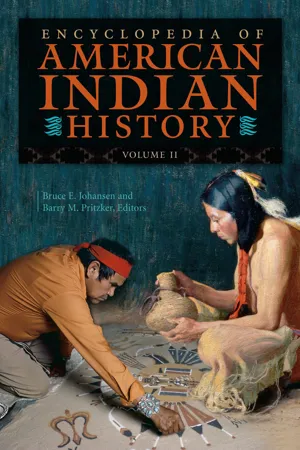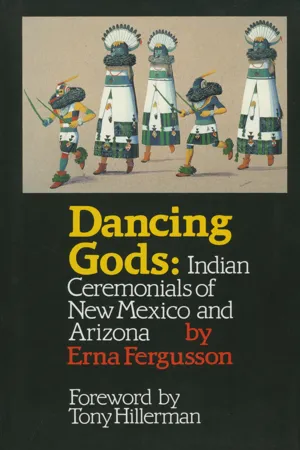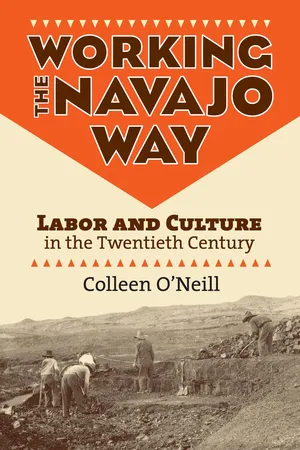History
Navajo Tribe
The Navajo Tribe is a Native American tribe known for their rich history and culture, including their traditional art, weaving, and jewelry. They have a strong connection to the land and are known for their skilled horsemanship. The tribe has a complex history, including their forced relocation by the U.S. government in the 1860s known as the "Long Walk."
Written by Perlego with AI-assistance
Related key terms
1 of 5
7 Key excerpts on "Navajo Tribe"
- eBook - PDF
Encyclopedia of American Indian History
[4 volumes]
- Bruce E. Johansen, Barry M. Pritzker, Bruce E. Johansen, Barry M. Pritzker(Authors)
- 2007(Publication Date)
- ABC-CLIO(Publisher)
1021 Navajo (Dine’é) Navajo (Dine’é) “Navajo” is a Tewa word meaning “planted fields.” The Navajos call themselves Dine’é, “the People.” Like the Apaches, they are of Athapaskan descent. Dinetah, the traditional Navajo homeland, is located on the lower Colorado Plateau, between the San Juan and Little Colorado Rivers, about seventy-five miles northwest of Santa Fe. Today’s Navajo Nation occu- pies a 28,800-square-mile reservation in northern Ari- zona and New Mexico and southern Utah. This land is mostly plateau (above 5,000 feet) and is marked by deep, sheer-walled canyons. The winters are cold, the summers are hot, and there is little water. The Dine’é are the most numerous Indian tribe in the United States. In 1990, 144,000 Indians lived on the Navajo Reservation, plus 1,177 at Cañoncito and 191 at Ramah. Many thousands also live off- reservation. More than 200,000 Indians now qualify for membership in the Navajo Nation (officially 219,198 in 1990). Perhaps 6,000 Navajos lived in the Dinetah in 1800. Navajo is an Athapaskan language. Roughly 3,000 years ago, the Athapaskans, along with others (all called the Na-Dene), began a new wave of Asian migration into North America. Nomadic hunter-gatherers, the southern Atha- paskans arrived in the Southwest in roughly 1400 and filled in the mountains around the Pueblo-held valleys. The northern Athapaskans remained in the subarctic. Sa’ah Naaghei Bik’en Hozho, which may be char- acterized as being grounded to the earth, whole, and in harmony with life, is the Navajo Way. Everything is sacred and interrelated. For instance, religion equals identity equals clan equals place. The chief role of ceremonialism is to maintain or restore this harmony. Therefore, most ceremonies are for curing illness, broadly defined as being off balance for any number of reasons, such as contact with non- Natives, ghosts, witches, or the dead. Navajo hogan and cornfield near Holbrook, Arizona, ca. - eBook - PDF
- T. Csordas(Author)
- 2002(Publication Date)
- Palgrave Macmillan(Publisher)
Here I will be concerned with cultural representation of events in which identity is at stake in the public sphere defined in part by the news media. On an inter me- diate level within Navajo society, healing and identity are closely interrelated in the interactions among three relatively distinct forms of healing. Specifically, I will highlight negotiation among participants in these healing forms around issues of competition and cooperation. Finally, on the indi- vidual level, healing frames the relation between personal and collective identity in terms of dignity and self-worth as a Navajo. Here, my focus is on the behavioral and experiential transformation of patients and their imme- diate social relations. Basing my presentation on this threefold analytic framework, I will return in the conclusion to the above-mentioned series of conceptual relations between religion and politics, tradition and modernity, individual and collective, microsocial and macrosocial. 1 Navajoland in the Nineties The Navajo (Dine) are an Athabaskan people who, along with the kindred Apache peoples, migrated south from Alaska and Canada to what is now the U.S. Southwest approximately 500 years ago, roughly the same time as Spaniards were migrating north from Mexico into the same region. The contemporary Navajo Nation comprises more than 17.5 million acres (roughly the size ofWestVirginia) in the Four Corners region where New Mexico, Arizona, Utah, and Colorado meet. It lies immediately to the east ofGrand Canyon National Park and completely surrounds the Hopi Indian reservation. The reservation and its boundaries are an institution of the U.S. federal government, established by an imposed treaty in 1868 as the condi- tion for the Navajos' release from captivity at Bosque Redondo near Fort Sumner in eastern New Mexico.The collective trauma ofthe LongWalk- their forced march into collective exile from their homeland, following military defeat by U.S. - eBook - ePub
Therapeutic Interventions with Ethnic Elders
Health and Social Issues
- Sara Aleman, Tanya Fitzpatrick, Thanh V Tran, Elizabeth Gonzalez, Sara Aleman, Tanya Fitzpatrick, Thanh V Tran, Elizabeth Gonzalez(Authors)
- 2014(Publication Date)
- Routledge(Publisher)
The history of the Indian Health Service (IHS) is also presented in this chapter. This is of paramount importance because the IHS delivers health services based on the Western medical model to the Navajo, and the majority of professionals are non-Native. The importance of evaluating health care from the perspective of those who are treated cannot be emphasized enough when looking at the Navajo elder. The room for misunderstanding between elders and the predominantly non-Native medical staff employed by IHS is great. These are people from two different worlds who are separated by language, culture, religion, and way of life.The following is a brief historical backdrop for understanding the history between the Diné and the United States government, which has fundamentally defined how many Diné elders deal with systems and individuals that are supposed to provide services to them and their families.The Diné
The Diné, a nomadic people and part of the NaDene language group, have language relatives in Alaska, Canada, Washington, Oregon, and California. Part of the Athabaskan ethnic group (Downs, 1972; Wood, Vannette, and Andrews, 1982), the Diné are centered in Arizona and New Mexico but can also be found in numbers over 1,000 in California, Colorado, Texas, and Utah. In 1990, 212,000 Diné registered with the Navajo Tribe and they made up 11.7 percent of the total American Indian population (U.S. Census Bureau, 1992). The majority of tribal members live on the Navajo Reservation, which consists of 27,000 square miles and spans the three states of Arizona, New Mexico, and Utah.As a colonized minority group, the Navajo have been assigned the curious position of outsiders in their own world. Effects of colonization in the form of boarding schools, hospitals, and churches have taken their toll on the Navajo people. Despite many difficulties, however, the Navajo have survived, and to understand where they are today, one must understand where they came from.The Beginning
The Navajo people believe in the four-world structure. The worlds are described as the black, blue, yellow, and white or glittering world. The First World was black, and four holy beings were created to run this new world. These holy beings were Water Monster, Blue Heron, Frog, and Lightning. These leaders were to govern the people in positive ways in order to promote good moral character and to prevent adultery and incest from occurring among the people. - Available until 31 Dec |Learn more
Dancing Gods
Indian Ceremonials of New Mexico and Arizona
- Erna Fergusson(Author)
- 1988(Publication Date)
- UNM Press(Publisher)
In appearance they are very different from the other southwestern Indians. One would say, offhand, that Navajos are a tall people, slim-waisted, both men and women, with high cheek-bones, narrow hands and feet. Yet on closer acquaintance they are seen to represent every human type. They are short and fat as well as long and lean; high aquiline noses and narrow faces are varied by flat faces and almost Negroid features. Probably Jewish traders could contribute little to the Navajo’s gift as a hard and close dealer, but Jewish features are not infrequent. A stunning sheik of the desert may have gray eyes; they are probably due to the fact that the American Army passed that way. Whatever his physical appearance, the Navajo’s outstanding characteristic is his hauteur. He is dignified to the point of superciliousness; and he looks upon the white man as upon a strange interloper whom he tolerates because it is his own high pleasure to do so, and not because he has to. That the Navajos consider themselves the aristocrats of the southwest they tacitly admit by calling themselves “Dinne,” the People. They are of Athapascan stock, and ethnologists are generally agreed that they came from the north, drifting into the area they now occupy less than a thousand years ago. In earliest historical times they were found wandering over what is now western New Mexico, eastern Arizona, and southern Utah and Colorado. Their present reservation, while much smaller than their original range, is in the same region. Navajo legends in general bear out the supposition that they came from the north, except one very picturesque one which tells that the People came from the south, bringing their four sacred plants: tobacco, corn, squash, and beans. They occupied all the country, but, finding the Pueblo people better fitted for agriculture, they generously gave them the valley lands and kept the high grassy uplands for themselves - eBook - PDF
Crime and Crime Control
A Global View
- Gregg Barak(Author)
- 2000(Publication Date)
- Greenwood(Publisher)
About one fourth of Navajos are supported by general assistance and welfare payments (Bailey and Bailey, 1986: 261). 104 CRIME AND CRIME CONTROL Employment, when it can be found, tends to be inadequate. Those who live in the rural areas have little or no access to work. Even in the larger reservation communities, part-time and seasonal work are common. By far, the largest source of full-time careers is the government, including occu- pations tied to the Navajo Nation's profitable leases to private companies for rights to mine the reservation's vast natural resources (e.g., oil, gas, uranium, and coal). The Dine' preference law states that Navajos must be hired over similarly qualified non-Navajos, but there are still many Bilagaa- naa (non-Indian outsiders) working on the reservation because they bring skills or certifications that are hard to find on tribal lands. The Navajo political system has evolved into a hybrid of the traditional as well as quasi-traditional and the imposed elements of the U.S. federal government. Navajo culture is strongly based in accommodation, both in- ternal and external. Early Navajo governance focused on consensus and an absence of intimidation. Their peace leaders were elected and had no co- ercive power over others (Wilkins, 1987). These leaders, naatfaanii, were selected for their wisdom, ability to keep the peace, and planning ability. Navajo ancient history (twelfth to sixteenth centuries) also demonstrates their overall flexibility as well as their ability to accommodate other cultural institutions, such as the way the Navajos adapted and incorporated the rich social and political heritages of their neighbors in the Southwest, namely, the Pueblos and the Spanish. - eBook - ePub
Working the Navajo Way
Labor and Culture in the Twentieth Century
- Colleen O'Neill(Author)
- 2005(Publication Date)
- University Press of Kansas(Publisher)
5These mountains embody tremendous power for the Diné. They provide the stories, life lessons, and values that are central to their culture. As respected elder and storyteller George Blueeyes described, “This is how they sit for us. / We adorn ourselves just as they do, / With bracelets of turquoise, / And precious jewels about your necks.” They mark the places that signify Diné origins and reaffirm their cultural identity. As Mr. Blueeyes continued,“These mountains and the land between them / Are the only things that keep us strong. / From them, and because of them we prosper. / It is because of them that we eat plants and / good meat.”6Today, each of the four sacred mountains lies beyond the political boundaries of the Navajo Reservation, which encompasses 25 ,000 square miles, crossing the borders of Arizona, New Mexico, and Utah and is often compared in size to the state of West Virginia. In 1930 , the Navajo population numbered between 39 ,000 and 40 ,000 people. A generation later, by 1960 , that number increased to 60 ,000 .7 By 1972 , over 120 ,000 people lived on the Navajo Reservation. Today, the Navajo nation is one of the largest American Indian communities in the United States, and its reservation is one of only a few that encompass ancestral lands.Map 1.1. Diné Bikéyah. Map drawn by Jorge Lizárraga.Diné Bikéyah, the Navajo homeland, is spectacular and varied terrain. In the mid-1940 s, the noted anthropologists Clyde Kluckhohn and Dorothea Leighton attempted to describe its totality, likening it to a massive landscape painting. They encouraged their readers to imagine “the sagebrush interspersed with groves of small evergreens . . . against a background of highly colored mesas, canyons, buttes, volcanic necks and igneous mountain masses clothed in deep pine green, [and] roofed over with a brilliant blue sky.”8 In 1982 - eBook - ePub
Anthropology of Migration and Multiculturalism
New Directions
- Steven Vertovec(Author)
- 2013(Publication Date)
- Routledge(Publisher)
In some ways attention to culture evokes the old distinction between acculturation and assimilation where acculturation focuses on values, meanings, and symbols, while assimilation points to aspects of social organization (family, class, intermarriage, institutions) (Gans 1997). But as someone familiar with the use of these terms to describe the supposed rapid disappearance of Native American populations, I want to break with this framework. In spite of over 150 years of assimilationist government policy, Native American cultures did not disappear and, some might argue have in the past thirty years gone through a renaissance. Among Native American populations there has been renewed attention to federal recognition, cultural and linguistic revival, and historic preservation. There has also been cultural innovation in the arts and music. Pan-Indian events and religious practices: powwow dancing, the sweat lodge, the Sun Dance and Native American Church ceremonies have also increased in popularity. All this points to an increasing emphasis on cultural difference among Native Americans.In this analysis I shall focus on women, since they are often the centre of family networks and the support system for family-based ceremonies. I shall also evoke two forms of bricolage ‘weaving’ and ‘stirring’ that utilize Navajo women’s activities as metaphors for the construction of cultural difference and identity.The Navajo family in New MexicoLet me now turn to the Navajo. I argue that we need to see cultural and social processes in the context of changes in the Navajo political economy over the last forty years. I originally conducted field research for my PhD dissertation in 1965–66 in a small Navajo community on the eastern side of the Navajo reservation. In my book, I call this community Copper Canyon.At that time, the Navajo were already shifting away from a pastoral-agricultural economy. The reservation was being transformed through the increased exploitation of its mineral resources and the growth of tribal, state and federal bureaucratic structures (primarily schools, hospitals and government offices). In the mid-1960s, regional migration was encouraged by the boarding school system and the Bureau of Indian Affair’s re-location programme that sent Navajo families to distant cities. Those who remained on the reservation found themselves more dependent on welfare and wages. In my 1965 census, 25 per cent of the 1000 Copper Canyon community members were living off-reservation, many in Denver, Los Angeles and Albuquerque. Livestock, farming and weaving only contributed 14 per cent of community income, while wages (including seasonal work for the railroad) made up 50 per cent and welfare and social security 24 per cent. The remaining income came from Tribal works programmes.






